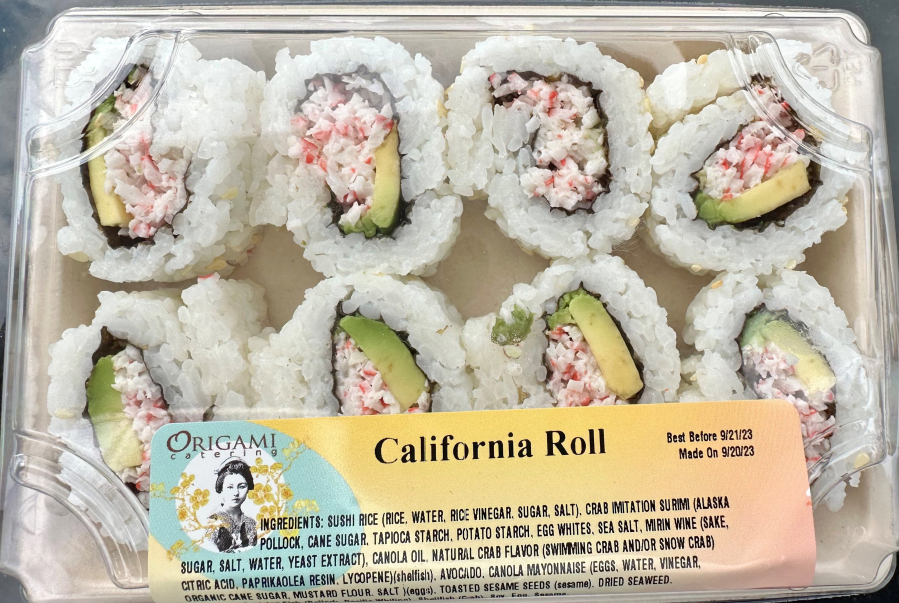Sushi stands have become as ubiquitous as fried chicken and pizza at grocery stores throughout the country. Americans purchased 43.7 million servings of sushi at grocery stores over the past year, according to the consumer research firm Circana.
I decided to put grocery-store sushi to the test, California rolls in particular, because they are the most popular and widely available variety of sushi. But first I had to figure out who supplies local grocery stores with sushi and if it’s any different from one store to the next.
Although Costco created a buzz by adding a sushi counter at its Issaquah store, a representative at a Vancouver store told me it has no similar plans right now.
In Clark County, Advanced Fresh Concepts Franchise Corp. offers sushi at the majority of Fred Meyer and Safeway stores. AFC is the largest North American franchise for supermarket-based sushi bars. This Southern California-based business had over 4,000 locations in three countries in 2017.
I found three other companies that supply stores here:
- Hissho Sushi, based in Charlotte, N.C., is the second largest sushi producer in the United States with 2,200 locations in 42 states.
- Snowfox Sushi also has a significant part of the raw fish and rice market with 1,300 full-service sushi kiosks in 38 states.
- Origami Catering is a smaller Portland-based company that provides grab-and-go sushi in the Pacific Northwest. Casey Bonsi, who trained with renowned sushi chef Shiro Kashiba, founded the company.
Sushi rolls have three main components: seasoned short-grain white rice, filling (typically vegetables and seafood) and seaweed (nori). Inexpensive sushi rice tends to clot together and become gluey when cooked. Higher quality sushi rice is sticky but the grains remain separate and tender.
After being cooked, sushi rice is mixed with rice vinegar seasoned with salt and sugar. Nori (seaweed) is placed on a bamboo rolling mat, slathered with warm rice, filled with things like cucumber, crab, and tuna, then rolled tight and sliced. Some grocery store kiosks have a window where shoppers can watch sushi being made.
California rolls are made of imitation crab, cucumber and avocado. The “crab” might be in sticks, shredded or mixed with mayonnaise. Imitation crab is made with surimi, a seafood paste of white fish, flavorings, starch, sugar and salt. It was created in Japan in the 1970s as an inexpensive alternative to crab.
Here’s what I tried:
- Snowfox Sushi from the Fred Meyer store at 11325 S.E. Mill Plain Blvd. in Vancouver (12 pieces for $6.49);
- AFC sushi from the Fred Meyer store at 2500 Columbia House Blvd. in Vancouver (10 pieces for $6.99);
- Origami Sushi from New Seasons Market at 2100B S.E. 164th Ave. in Vancouver (8 pieces for $9.99); and
- Hissho Sushi from the Safeway store at 3307 Evergreen Way in Washougal (12 pieces for $7.49).
The cucumber, avocado and imitation crab in each of these rolls were of similar freshness and quality. The differences in these offerings came down to the rice. Superior rolls had rice that flaked into individual tender grains and wasn’t overly compacted and rubbery in texture.
The best sushi I tried was from AFC. The quality and freshness of the rice gave it an edge over the other sushi I sampled. This is good news for sushi lovers because AFC supplies sushi to most Fred Meyer and Safeway locations in Vancouver, as well as the Fred Meyer store in Battle Ground.
A close second was Origami Sushi from New Seasons. This was the priciest. The rice was of a good quality but it was slightly harder than the rice from AFC. Origami’s California roll didn’t have cucumber, which was a nice addition in the other rolls I tried. Origami’s label had the shortest list of ingredients (and the fewest I didn’t recognize) of all the brands I tried.
Snowfox sushi and Hissho sushi tied for third because the rice in both of these rolls was overly sticky, compacted and gluey.
Nonetheless, I was pleasantly surprised by the freshness and flavor of all the sushi I tried. I was expecting packaged grocery store sushi to be stiff and flavorless, but what I found was far better than anticipated — especially for the convenience and the price.




